Withdrawal
Attention.
- Use protective coatings to prevent damage to painted surfaces.
- Disconnect connectors carefully while holding the connector with your hand to avoid damage.
Note: Label all wires and hoses to avoid reconnection errors. To relieve pressure in the fuel system before removing the engine, start the engine without the fuel pump relay. Then stop the engine with the ignition key.
1. Disconnect the wire from the negative terminal (A) battery.
Note: Tightening torque: 4.0-6.0 Nm.
2. Remove the cover (IN) engine.
3. Remove the duct (WITH).

4. Disconnect the hose (A) breather, air intake hose (IN) and remove the air filter assembly (WITH).
Note:
Torque:
- Hose clamp bolt: 2.9-4.9 Nm.
- Air filter mounting bolts: 7.8-11.8 Nm.
5. Disconnect the positive battery terminal, then remove the battery (D).
Note:
- Tightening torque: 7.8-11.8 Nm.
- Bracket bolt: 9.8-11.8 Nm.

6. Disconnect the engine control unit connector (ECM), then remove the block (A) and a shelf (IN) battery.
Note: Tightening torque: 9.8-11.8 Nm.

7. Remove protection (A) engine.
Note: Tightening torque: 19.6-24.5 Nm.

8. Remove the drain plug (A) and drain the coolant. Remove the radiator cap to speed up draining.

Attention. Never remove the radiator cap when the engine is hot. Otherwise, high-pressure hot fluid may be ejected from the radiator, which could cause severe burns.
9. Remove the top (A) and bottom (IN) radiator hoses.

10. Drain the refrigerant and remove the high and low pressure fittings.

11. Disconnect the positive (+) the wire (A) from fuse box and front connector (IN).
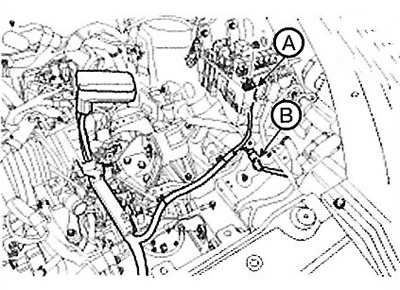
12. Disconnect connectors and wiring clamps from engine.
(1) Oil control valve connector (OCV) (A)
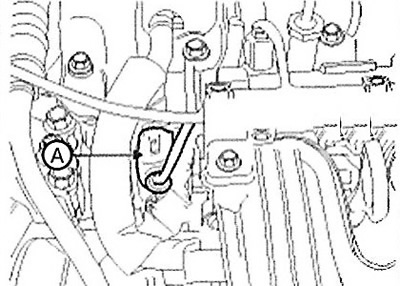
(2) Connector (A) intake manifold geometry change systems (VIS).
(3) Sensor (IN) oil pressure.
(4) Connector (WITH) knock sensor.
(5) Connector (D) air conditioner compressor switch.
(6) Generator connector (E).
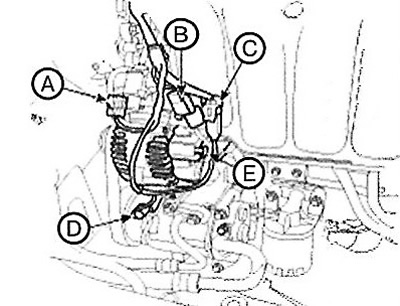
(7) Connectors (A) nozzles.
(8) Connectors (IN) ignition coils.
(9) Connector (WITH) intake camshaft position sensor.
(10) Connector (D) intake camshaft position sensor.
(11) Connector (E) oil control valve (OCV) exhaust valves.

(12) Connector (A) electronic throttle control systems (ETC).
(13) Connectors (IN) intake manifold absolute pressure sensors (IDA) and intake air temperature (IATS).

(14) Connector (A) purge control solenoid valve (PCSV).
(15) Connector (IN) coolant temperature sensor (ECTS).
(16) Connector (WITH) capacitor.
(17) Connector (D) crankshaft speed sensor.
(18) Connector (E) oxygen sensor.

13. Disconnect the wiring harness connectors and the transmission control cable.
14. Remove the front wheels.
15. Remove shock absorbers, stabilizer links and tie rod ends.
16. Disconnect the drive shafts from the hubs.
17. Remove the bolt (A) mounting of the universal joint of the steering shaft.

18. Disconnect the power steering return hose to drain the oil. Then remove the hose connecting the power steering pump and expansion tank.
19. Disconnect the fuel hose (A), vacuum hose (IN) brake booster and hoses (WITH) heater.

20. Remove the front muffler (A).
Note: Tightening torque: 39.2-58.8 Nm.

21. Remove bracket A from the rear roller stop.
Notes: Tightening torque: 107.9 - 127.5 Nm.
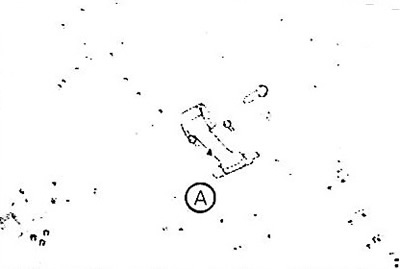
22. Remove the subframe.
23. Support the engine and transmission with a jack.
24. Disconnect the wire «masses», then remove the bracket (A) engine mounts.
Note: Tightening torque: 63.8-83.4 Nm.
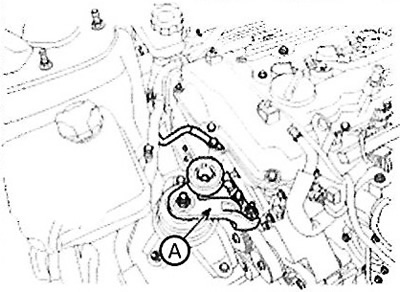
25. Disconnect the wire «masses», then loosen the bolt (A) gearbox support bracket.
Note: Tightening torque: 88.3-107.9 Nm.

26. Remove the engine and transmission assembly by lifting the vehicle.
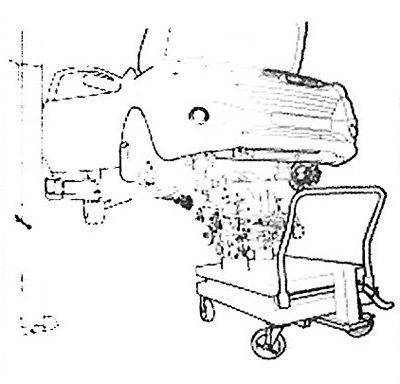
Attention. When removing the engine and transmission assembly, be careful not to damage surrounding components and the bodywork.
Installation
1. Installation is carried out in the reverse order.
2. Adjust shift cable.
3. Adjust throttle cable.
4. Fill with engine oil.
5. Fill in a working liquid in a transmission.
6. Fill in a working liquid in the hydraulic booster of a steering.
7. Fill the radiator and expansion tank with coolant.
8. Set the heater control to position «NOT» (HOT AIR).
9. Clean battery terminals and wire clamps before installation.
10. Check for a fuel leak.
11. After assembling the fuel line, turn the ignition switch to the ON position (do not turn on the starter), to let the fuel pump run for about two seconds and pressurize the fuel line.
12. Repeat this operation two or three times, and then check for fuel leaks.
13. Remove air from the cooling system.
14. Start the engine and let it warm up (until the radiator fan turns on 3-4 times).
15. Stop the engine and let it cool down. Check the coolant level and top up if necessary. This will remove air from the cooling system.
16. Install the radiator cap firmly, restart the engine and check for leaks.
